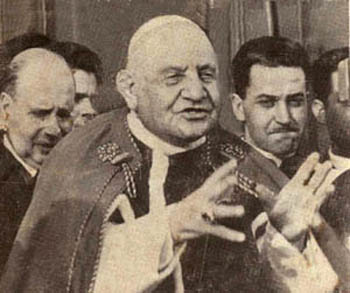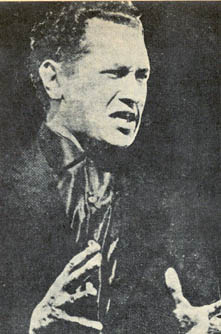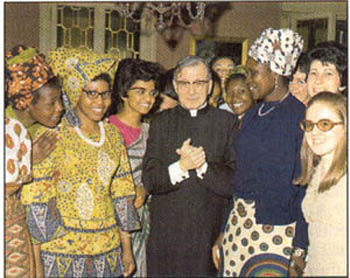 |
New Canonizations
The New Beatifications Create Confusion
Atila S. Guimarães
With the promulgation of the new Code of Canon Law, John Paul II instituted the practice of granting a beatification or canonization of a person from each country or region that he visits, or simply when he wants to please some movement or country. To do this with greater ease, he eliminated several stages of the serious process that had existed until then. With this, beatifications have lost much in the way of gravity and sacrality, and taken on the aspect of a Pope bestowing favors whenever and wherever he chooses.
Abolishing the traditional concept of martyr
This practice, born from the simplification of the processes of beatification and canonization, is causing confusion among the faithful. Let me take, for example, the case of Fr. Maximillian Kolbe, who was declared a martyr of charity by John Paul II; beatified on October 17, 1971, and canonized on October 10, 1982. Most probably the edifying life of Fr. Kolbe would permit him to be raised to the altars following the requirements of the ordinary process, but John Paul II canonized him as a martyr, even though his death did not fulfill the conditions required for such. This is cause for confusion.

John XXII's beatification seems a maneuver to halt the public's general rejection of Vatican II, convened by him (click here) |
André Frossard, a friend and confidante of John Paul II, explained the thinking behind this decision in an interview for Paris-Match magazine:
“Recalling the unexpected incidents involved with his [Fr. Maximillian Kolbe’s] canonization, I noticed that something extraordinary had occurred: Against the opinion of nearly all the experts, John Paul II decided to give him the title of martyr of the Faith. You know that Kolbe died in Auschwitz after having sacrificed himself by taking the place of a man condemned to death. This death in no way corresponds to the traditional definition of Christian martyrdom, so the Pope’s action will oblige the Church to make a thorough review of this definition ….
“According to the Church’s age-old tradition, martyrdom is ‘a testimony of faith even unto death, inflicted by hatred of the Faith.’ These four elements are all considered indispensable: a testimony, the Faith, death, hatred of the Faith. Now then, in Kolbe’s case, no matter how keenly the history of his death was scrutinized, one element was always missing, and especially the fourth. Indeed, in Kolbe’s death there is no trace of ‘hatred of the Faith’ ….
“Nonetheless, John Paul II personally became more and more favorable to the hypothesis of martyrdom. In his view, a prisoner of a concentration camp run by a totalitarian system would find himself in the same situation as an early Christian in the dungeons of a Caesar. In those times, the Christians were required to worship a divinized Caesar. Refusal meant death …. In a totalitarian regime, the situation [in his opinion] would be the same …. Thus Kolbe, facing a totalitarian and, therefore, ‘martyrogenic’ system, refused to serve it and answered only to his own conscience. And for this reason, he was put to death. That is why John Paul II …. canonized Maximillian Kolbe as a martyr of the Faith ….
“Let us return now to the victims of Nazism: One who dies for refusing to obey the system in the end dies for having defended the dignity of the human person. But for a Christian, every human person is like unto the person of Christ. You can see the conclusion: Anyone who dies for having defended the dignity of the human person may be considered a martyr, even if he is a non-believer. In the final analysis, such reasoning could lead to the belief that all victims of concentration camps, be they Christians, Jews or atheists, can be considered martyrs. As you can imagine, when this consideration is presented to the Pope, he does not disagree” (1).
The future would prove Frossard right in his analysis of the new criteria for the selection of martyrs. In fact, more recently Dom Bernardo Oliveira, the Abbot General of the Trappists, presented a long, detailed comparative analysis of the traditional criteria for selecting martyrs and the new norms, deciding in favor of the latter. He presented his thesis as justification for making an eventual common martyrology for all the so-called Christian religions. The Abbot’s considerations were published in L’Osservatore Romano, the daily news organ of the Holy See. Some of his more significant statements follow.
Speaking about the innovations of Vatican II on this topic, the Abbot observed they justified the new criteria:
“The Council ended the sad debate about the possibility of recognizing authentic martyrs in other Christian churches: ‘It is right and salutary to recognize the riches of Christ and virtuous works in the lives of others who are bearing witness to Christ, sometimes even to the shedding of their blood. For God is always wonderful in His works and worthy of admiration’ (UR 4h). In short, the Council has taught us to associate martyrdom with charity, and not just with faith” (2).
It is worth mentioning that the defense of the Faith, the traditional criterion for conferring the title of martyr, has been abolished.
A martyr would be one who has suffered a violent death for any cause
Consequently, the new criterion for the title of martyr is no longer an external fact, visible and verifiable by witnesses. Rather, it is an evaluation that attempts to measure the degree of charity of the individual, a necessarily subjective opinion that is difficult to prove objectively. With this innovation, the worthy aphorism de internis nec Ecclesia [the Church does not judge intentions] is discarded, in order to inaugurate a different kind of examination, subjective on the part of both the one who analyzes and the one who is analyzed. Obviously, the integrity of the conclusions of this practice are open to question.

According to the new criteria, Fr. Camilo Torres, the communist guerrilla priest, could be declared a martyr |
Basing himself upon those whom John Paul II has declared martyrs and justifications presented by the Pontiff in important documents – Evangelium vitae, Veritatis splendor, Ut unum sint, Tertio millennio adveniente – the Trappist Abbot laid out some new rules that should guide the pan-Christian martyrology. He affirmed that the new martyrs of the future would be those who “bear witness to life, in face of the threat of a life-threatening situation within the context of a culture of death” (3).
The criteria are quite vague ... A martyr should “bear witness to life,” he says, but what kind of life – human, animal, vegetable? It is not specified. Also, the reference to the “culture of death” is certainly not clear. To accept the term in its current meaning, without any restrictions, one might even go so far as to say that an ecologist who fights to preserve fish life in rivers and oceans, like Jacques Cousteau, could be considered as a martyr or saint tomorrow. The same could be said about someone who fights against pollution. Could the glory of the altars be reduced to this?
But the Abbot is not finished. He has more to say on what should define a martyr:
Martyrs would be “those who give testimony, even to their voluntary acceptance of a violent death, of their fidelity to the sacred law of God in defense of the intangibility of personal dignity and a broadly anticipated social justice” (4).
Here also the criteria are not sufficiently clear. The so-called martyr is supposed to have given his life in defense of the “intangibility of personal dignity,” but this goal cannot be objectively defined. Nor can one understand what is meant by a “broadly anticipated social justice.” On one hand, it could appear the considerations of Frossard (above), where he says those who die as victims of oppression can be considered martyrs, are valid. On the other hand, one could say that every leftist, be he Catholic, Protestant, or Schismatic, could be considered a martyr. Broadly applied, this new standard could permit the collective canonization of those without land, houses, documents, etc. who suffer violent deaths.
The Trappist Superior General presented another criterion:
Martyrs would be “those who give testimony to their radical adhesion to Christ and to the Father, supported by Baptism which is a solid foundation for the unity of all Christians, transcending all divisions” (5)
This norm is so wide-ranging that it would allow both the Catholics and Protestants who died in religious wars fighting each other to be considered martyrs. In all rigor, one could also include as martyrs the Jews and Palestinians who nowadays kill each other in Israel for religious reasons. With this expansive criterion that extends to harbor even opposed parties, this new concept of martyr reveals its absurdity. How would it be possible to say that two enemies who kill each other on the battlefield fighting for opposite religions are both martyrs?

Fr. Escriva de Balaguer: hardly the moral profile of a saint |
What becomes clear is the Abbot’s desire to make the traditional Catholic concept of martyr totally relativist.
The relativization of the concept of martyr would go so far that the Abbot himself stated there were almost no limits to its application:
“A single model of the martyr does not exist. In effect, there are as many models as there are immediate causes, social, political, and cultural circumstances, as well as religious and theological dimensions of the diverse experiences of the martyrs” (6).
What he seems to be saying is that any cause or circumstance for offering one’s life could make one a martyr.
In summary, he stated, “The only valid reason to lose one’s life as a martyr is love …. This communion of love logically can be realized in infinitely diverse circumstances” (7).
These are the new criteria that radically change the notion of martyrdom that has always existed in the Catholic Church, in order to make way for a pan–Christian martyrology and later, possibly, a pan-religious one.
Today a man who committes suicide can be considered a martyr
Applying these relativist criteria, Avvenire, an organ of the Italian Bishops’ Conference, took a supportive position regarding the suicide of a Pakistani Bishop in 1998. Bishop John Joseph of Faisalabad shot himself in the head to protest against the death penalty sentence that had been carried out on one of his faithful, Ayub Massih. In accordance with Muslim law, Ayub Massih was sentenced to death for blasphemy, for having publicly defended the book Satanic Verses by author Salman Rushdie. One can see that both the innocence of Massih and the idealism of Bishop Joseph are quite debatable. Commenting on the suicide of the Prelate, however, Bishop Emmanuel Yousaf of Lahore said, “We should not call it suicide, because Bishop Joseph sacrificed his life fighting against injustice” (8).
Avvenire also published a long commentary by Enzo Bianchi, Prior of the Community of Bose, Italy, about the tragedy. The Prior saw in the action of Bishop Joseph “a very rare form of martyrdom” (9). To consider someone who has committed suicide as a martyr is something completely and radically opposed to time-honored Catholic teaching on the subject. Once it would have been considered by everyone as an outrageous absurdity.
The future beatifications will be declared by the Bishops Conferences
In a Council intervention, Cardinal Leo Joseph Suenens addressed the topic of the processes of beatification. He proposed that Bishops Conferences be given the power to fully conduct the processes of beatification and canonization for their regional saints. In a later work, he explained the purpose of his suggestion:
“This intervention aimed to introduce a type of decentralization in the domain of beatification. In a collection of works, Sainteté d’hier et sainteté d’aujourd’hui, one of the authors summarized my intervention quite well with these words:
“‘In face of this alienation of public opinion in the process of canonization, one could ask if it would be advantageous for the proclamation of sanctity to no longer necessarily be made at the level of the universal Church. In an intervention during the third session of the Council, Cardinal Suenens suggested that the Bishops Conferences be granted the power to fully conduct the processes of beatification: these would be carried out by a commission of priests and laymen, and then submitted for the Pope’s approval. Canonization by the Holy See would thus be reserved for saints who are already beatified and enjoy a reputation and veneration beyond the borders of their own countries. The saints canonized by Rome would be added to the list of the saints of the universal Church; those who were beatified by the Bishops’ Conferences would be proposed as models and examples only in their own countries.
“‘This procedure would revive the practice used in the West during the first millennium. And it would go along with the present custom of the Orthodox Church, which makes a distinction between ecumenical, national, and local canonization. Above all, it would allow the community to resume an active role in this domain; without this, the naming of new saints runs the risk of being reduced to a mere formality (10).’
“The same argument was defended in the United States in a work entitled Making Saints.” (11).
We have not yet seen this new development predicted by Cardinal Suenens. So far it has not appeared necessary, since John Paul II has inflated the number of Blesseds and Saints beyond all expectations.
There are so many new beatifications and canonizations, and many of them with a sanctity quite disputable, that the faithful hardly pay attention to them any longer. The Catholic public is simply silent in face of this exaggerated inflation of saints unprecedented in the History of the Church.
“The silence of the people is a lesson for Kings,” says a wise aphorism. Meaning that when the people do not agree with the King, they remain silent rather than present their opposition openly. The King understands that this silence represents disapproval and acts accordingly. The same applies to the Pope.
I respect those who are in silent disagreement with John Paul II. They still think that he is well-intentioned and sincerely wants to glorify the many persons he has declared blessed. But I have taken a step further in such disagreement. I am convinced that he is carrying out another item of the progressivist agenda, which is to diminish the notion of sanctity in the Church.
1. André Frossard, interview in Paris-Match, May 29, 1987.
2. Bernardo Oliveira, “Martiri cristiani, ieri e oggi,” L’Osservatore Romano, May 21, 1998, p. 7.
3. Ibid.
4. Ibid.
5. Ibid.
6. Ibid.
7. Ibid.
8. “Non dobiamo chiamarlo suicida. L’estrema testimonianza del Vescovo pakistano,” Adista, May 16, 1998, p. 6.
9. Enzo Bianchi, “Il suicidio del Vescovo pakistano Joseph,” 30 Giorni, May 1998, p. 36.
10. Philippe Rouillard, Sainteté d’hier et sainteté d’aujourd’hui, Paris: Desclée de Brouwer, 1966.
11. Kenneth Woodward, Making Saints, New York: Schuster, 1990.
12. Leo Joseph Suenens, Souvenirs et espérances, Paris: Fayard, 1991, pp. 122-3.

Posted December 13, 2004

Related Topics of Interest
 A 'Saint Factory' A 'Saint Factory'
 Doubts about the Sanctity of John XXIII Doubts about the Sanctity of John XXIII

Related Works of Interest
|
New Canonizations | Home |
Books | CDs |
Search | Contact Us |
Donate

© 2002- Tradition in Action, Inc. All Rights
Reserved
|
 |
|